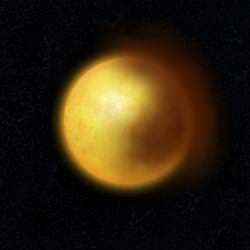Most stars shine with a brilliant light, barely changing for billions of years. Others vary in brightness dramatically, dimming and brightening in a period of days, weeks or months. One class, called R Coronae Borealis are erratic in their cycles of brightening and dimming, and now astronomers think they know why: they’re hiding behind a dusty blanket.
An international team of astronomers from France and Brazil has detected a huge cloud of dust around an R Coronae Borealis star called RY Sagittarii, lending evidence to the theory that these stars are actually enshrouding themselves in dust, and hiding from view.
The theory goes that these stars, which can be 50 times larger than our Sun, puff out an envelope of dust around themselves. As this cloud moves into our line of sight from the Earth, it eclipses the star. From our point of view, the star dims in brightness. Then as the solar radiation blasts the dust particles away, the star brightens again.
The researchers used ESO’s Very Large Telescope Interferometer to clearly detect the presence of clouds around a variable star called RY Sagittarii. This was the first time these dust clouds were ever directly detected. The brightest dust cloud was detected several hundred stellar radii away from the centre of the star, so it had clearly drifted away. They discovered that a huge envelope surrounds the star in an area 120 times as big as RY Sagittarii itself.
The cloud is traveling at a speed of 300 km/s, so the astronomers calculated that it was probably ejected about 6 months before it was discovered. They’re planning to perform follow up observations on RY Sagittarii to understand how these dust clouds are formed, and how they dissipate.
Original Source: ESO News Release

